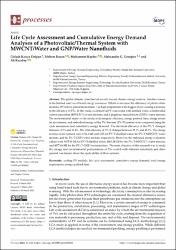| dc.contributor.author | Karaca Dolgun, Gülşah | |
| dc.contributor.author | Koşan, Meltem | |
| dc.contributor.author | Kayfeci, Muhammet | |
| dc.contributor.author | Georgiev, Aleksandar G. | |
| dc.contributor.author | Keçebaş, Ali | |
| dc.date.accessioned | 2023-04-25T13:23:03Z | |
| dc.date.available | 2023-04-25T13:23:03Z | |
| dc.date.issued | 2023 | en_US |
| dc.identifier.citation | Dolgun, G.K.; Ko ̧san, M.; Kayfeci, M.; Georgiev, A.G.; Keçeba ̧s, A. Life Cycle Assessment and Cumulative Energy Demand
Analyses of a Photovoltaic/Thermal System with MWCNT/Water and GNP/Water Nanofluids. Processes 2023, 11, 832. https://doi.org/10.3390/pr11030832 | en_US |
| dc.identifier.isbn | 22279717 | |
| dc.identifier.uri | https://doi.org/10.3390/pr11030832 | |
| dc.identifier.uri | https://hdl.handle.net/20.500.12809/10672 | |
| dc.description.abstract | The global climate crisis has led society toward cleaner energy sources. Another reason is the limited reserves of fossil energy resources. Efforts to increase the efficiency of photovoltaic modules (PVs) have gained momentum. The high temperature is the biggest factor causing a decrease in the efficiency of PVs. In this study, a commercial PV was cooled with distilled water, a multiwalled carbon nanotubes (MWCNT)/water mixture, and a graphene nanoplatelets (GNP)/water mixture. The environmental impact of electricity, total energetic efficiency, energy payback time, energy return on investment, and embodied energy of the PV/thermal (PV/T) system were compared using life cycle assessment and cumulative energy demand. The electrical efficiency of the PV/T changed between 13.5% and 14.4%. The total efficiency of PV/T changed between 39.5% and 45.7%. The energy returns on investment were 1.76, 1.80, and 1.85 for PV/T-distilled water, the PV/T-MWCNT/water mixture, and the PV/T-GNP/water mixture, respectively. Moreover, the embodied energy evaluation values were 3975.88 MJ for PV/T-distilled water, 4081.06 MJ for the PV/T-MWCNT/water mixture, and 4077.86 MJ for the PV/T-GNP/water mixture. The main objective of this research was to study the energy and environmental performances of PVs cooled with different nanofluids and draw general conclusions about the applicability of these systems. | en_US |
| dc.item-language.iso | eng | en_US |
| dc.publisher | MDPI | en_US |
| dc.relation.isversionof | 10.3390/pr11030832 | en_US |
| dc.item-rights | info:eu-repo/semantics/openAccess | en_US |
| dc.subject | Cooling PV module | en_US |
| dc.subject | Life cycle assessmen | en_US |
| dc.subject | Cumulative energy demand | en_US |
| dc.subject | total energy requirement | en_US |
| dc.title | Life Cycle Assessment and Cumulative Energy Demand Analyses of a Photovoltaic/Thermal System with MWCNT/Water and GNP/Water Nanofluids | en_US |
| dc.item-type | article | en_US |
| dc.contributor.department | MÜ, Teknoloji Fakültesi, Enerji Sistemleri Mühendisliği Bölümü | en_US |
| dc.contributor.authorID | 0000-0003-4809-2461 | en_US |
| dc.contributor.institutionauthor | Karaca Dolgun, Gülşah | |
| dc.contributor.institutionauthor | Keçebaş, Ali | |
| dc.identifier.volume | 11 | en_US |
| dc.identifier.issue | 3 | en_US |
| dc.relation.journal | Processes | en_US |
| dc.relation.publicationcategory | Makale - Uluslararası Hakemli Dergi - Kurum Öğretim Elemanı | en_US |


















